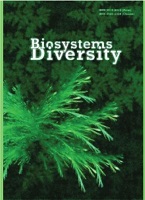Growth and morphological characteristics of some pyrophilous discomycetes in culture
Growth and morphological characteristics of some pyrophilous discomycetes in culture
Author(s): V. Dzhagan, T. Krupodorova, A. Atamanchuk, Y. Lytvynenko, V. DzhaganSubject(s): Energy and Environmental Studies, Environmental interactions
Published by: Дніпропетровський національний університет імені Олеся Гончара
Keywords: Anthracobia;Pyronema;Tricharina;growth parameters; culture description; Raman spectroscopy;
Summary/Abstract: Three pyrophilous discomycetes species (Anthracobia maurilabra (Cooke) Boud., Pyronema domesticum (Sowerby) Sacc. and Tricharina praecox (P. Karst.) Dennis) have been cultivated and studied in vitro. Cultures were obtained from fresh apothecia сollected in the Holosiivskyi National Nature Park (Kyiv, Ukraine). The culture growth and morphological characteristics of the studied fungi on different media (beer wort agar, Czapek Dox agar, potatodextrose agar) were analyzed. All investigated species can quite easily grow under laboratory conditions on different tested nutrient media. Potato-dextrose agar was the most suitable medium for the enhancement of radial growth and the best expresses all the phenotypes of the colony of studied fungi. Macro- and micromorphological descriptions of all fungal colonies and illustrations are provided. The micromorphological analysis showed that common to the mycelium of all studied species of fungi was the presence of numerous drops of oil in the hyphae, anastomoses like T. praecox, а net- like structure of A. maurilabra similar to nematode capture hook. Beside this, A. maurilabra and P. domesticum formed the sexual stage under experimental conditions. Forming fruiting bodies of A. maurilabra in culture has not been reported before. Moreover, P. domesticum was found to form abundant dark brown sclerotia on potato-dextrose agar and Czapek Dox agar. Possible pigment composition in the P. domesticum sclerotia is discussed based on the Raman spectroscopy study, performed on this genus for the first time. The established cultural characteristics can be useful for taxonomic identification of fungal species and for pure quality control of mycelial cultures during their introduction, preservation and future potential applications in biotechnological areas.
Journal: Biosystems Diversity
- Issue Year: 31/2023
- Issue No: 3
- Page Range: 282-289
- Page Count: 8
- Language: English

